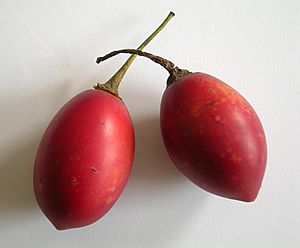Tamarillo facts for kids
The tamarillo is a cool fruit that grows on a small tree or a big bush. It's part of the nightshade family, just like tomatoes and potatoes! This fruit is shaped like an egg and can be 4 to 10 centimeters long. It tastes a bit like a tomato, but it's less sweet and a little more salty.
Contents
What is a Tamarillo?
The tamarillo is also known as the "tree tomato." It's a type of plant that can grow as a shrub (a bushy plant) or a small tree. It's famous for its tasty, egg-shaped fruit. The fruit has a smooth, shiny skin that can be red, orange, or even yellow when it's ripe. Inside, the flesh is juicy and can be orange or reddish.
Where Do Tamarillos Come From?
Tamarillos originally grew in the Andes mountains of South America. You can find them naturally in countries like Ecuador, Colombia, Peru, Chile, and Bolivia. People there have been eating them for a very long time!
How Do Tamarillos Grow?
Tamarillo plants grow quite fast. They like places that are not too hot and not too cold. They need good soil and plenty of water to grow well. The plants can start giving fruit after just a couple of years. Each plant can produce lots of fruit, which is great for farmers.
What Does a Tamarillo Taste Like?
Imagine a mix between a tomato and a passion fruit, and you're getting close! The taste of a tamarillo is unique. It's often described as tangy and slightly sweet, with a bit of a savory flavor. The skin can be a little bitter, so many people prefer to peel it before eating.
How to Eat a Tamarillo
There are many ways to enjoy a tamarillo:
- You can cut it in half and scoop out the juicy flesh with a spoon.
- Peel it and slice it into salads.
- Cook it into jams, chutneys, or sauces.
- Blend it into smoothies or juices for a refreshing drink.
Uses of Tamarillos
Tamarillos are not just tasty; they're also full of good things for your body! They have vitamins, especially Vitamin C, which helps keep you healthy. They also have fiber, which is good for your digestion.
Tamarillos Around the World
Even though they started in South America, tamarillos are now grown in many other parts of the world. Countries like New Zealand, Australia, and parts of Africa also grow them. New Zealand even helped give the fruit its modern name, "tamarillo," in the 1960s to make it sound more exciting and exotic!
Images for kids
See also
In Spanish: Tomate de árbol para niños







